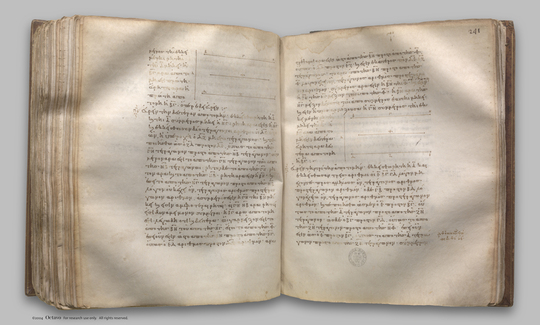index prev next | digilib folio 245

To find the second apotome.
| Εὑρεῖν τὴν δευτέραν ἀποτομήν. Ἐκκείσθω ῥητὴ ἡ Α καὶ τῇ Α σύμμετρος μήκει ἡ ΗΓ. ῥητὴ ἄρα ἐστὶν ἡ ΗΓ. καὶ ἐκκείσθωσαν δύο τετράγωνοι ἀριθμοὶ οἱ ΔΕ, ΕΖ, ὧν ἡ ὑπεροχὴ ὁ ΔΖ μὴ ἔστω τετράγωνος. καὶ πεποιήσθω ὡς ὁ ΖΔ πρὸς τὸν ΔΕ, οὕτως τὸ ἀπὸ τῆς ΓΗ τετράγωνον πρὸς τὸ ἀπὸ τῆς ΗΒ τετράγωνον. σύμμετρον ἄρα ἐστὶ τὸ ἀπὸ τῆς ΓΗ τετράγωνον τῷ ἀπὸ τῆς ΗΒ τετραγώνῳ. ῥητὸν δὲ τὸ ἀπὸ τῆς ΗΓ. ῥητὸν ἄρα [ ἐστὶ ] καὶ τὸ ἀπὸ τῆς ΗΒ: ῥητὴ ἄρα ἐστὶν ἡ ΒΗ. καὶ ἐπεὶ τὸ ἀπὸ τῆς ΗΓ τετράγωνον πρὸς τὸ ἀπὸ τῆς ΗΒ λόγον οὐκ ἔχει, ὃν τετράγωνος ἀριθμὸς πρὸς τετράγωνον ἀριθμόν, ἀσύμμετρός ἐστιν ἡ ΓΗ τῇ ΗΒ μήκει. καί εἰσιν ἀμφότεραι ῥηταί: αἱ ΓΗ, ΗΒ ἄρα ῥηταί εἰσι δυνάμει μόνον σύμμετροι: ἡ ΒΓ ἄρα ἀποτομή ἐστιν. Λέγω δή, ὅτι καὶ δευτέρα. Ὧι γὰρ μεῖζόν ἐστι τὸ ἀπὸ τῆς ΒΗ τοῦ ἀπὸ τῆς ΗΓ, ἔστω τὸ ἀπὸ τῆς Θ. ἐπεὶ οὖν ἐστιν ὡς τὸ ἀπὸ τῆς ΒΗ πρὸς τὸ ἀπὸ τῆς ΗΓ, οὕτως ὁ ΕΔ ἀριθμὸς πρὸς τὸν ΔΖ ἀριθμόν, ἀναστρέψαντι ἄρα ἐστὶν ὡς τὸ ἀπὸ τῆς ΒΗ πρὸς τὸ ἀπὸ τῆς Θ, οὕτως ὁ ΔΕ πρὸς τὸν ΕΖ. καί ἐστιν ἑκάτερος τῶν ΔΕ, ΕΖ τετράγωνος: τὸ ἄρα ἀπὸ τῆς ΒΗ πρὸς τὸ ἀπὸ τῆς Θ λόγον ἔχει, ὃν τετράγωνος ἀριθμὸς πρὸς τετράγωνον ἀριθμόν: σύμμετρος ἄρα ἐστὶν ἡ ΒΗ τῇ Θ μήκει. καὶ δύναται ἡ ΒΗ τῆς ΗΓ μεῖζον τῷ ἀπὸ τῆς Θ: ἡ ΒΗ ἄρα τῆς ΗΓ μεῖζον δύναται τῷ ἀπὸ συμμέτρου ἑαυτῇ μήκει. καί ἐστιν ἡ προσαρμόζουσα ἡ ΓΗ τῇ ἐκκειμένῃ ῥητῇ σύμμετρος τῇ Α. ἡ ΒΓ ἄρα ἀποτομή ἐστι δευτέρα. Εὕρηται ἄρα δευτέρα ἀποτομὴ ἡ ΒΓ: ὅπερ ἔδει δεῖξαι. | To find the second apotome. Let a rational straight line A be set out, and GC commensurable in length with A; therefore GC is rational. Let two square numbers DE, EF be set out, and let their difference DF not be square. Now let it be contrived that, as FD is to DE, so is the square on CG to the square on GB. [X. 6, Por.] Therefore the square on CG is commensurable with the square on GB. [X. 6] But the square on CG is rational; therefore the square on GB is also rational; therefore BG is rational. And, since the square on GC has not to the square on GB the ratio which a square number has to a square number, CG is incommensurable in length with GB. [X. 9] And both are rational; therefore CG, GB are rational straight lines commensurable in square only; therefore BC is an apotome. [X. 73] I say next that it is also a second apotome. For let the square on H be that by which the square on BG is greater than the square on GC. Since then, as the square on BG is to the square on GC, so is the number ED to the number DF, therefore, convertendo, as the square on BG is to the square on H, so is DE to EF. [V. 19, Por.] And each of the numbers DE, EF is square; therefore the square on BG has to the square on H the ratio which a square number has to a square number; therefore BG is commensurable in length with H. [X. 9] And the square on BG is greater than the square on GC by the square on H; therefore the square on BG is greater than the square on GC by the square on a straight line commensurable in length with BG. And CG, the annex, is commensurable with the rational straight line A set out. Therefore BC is a second apotome. [X. Deff. III. 2] |